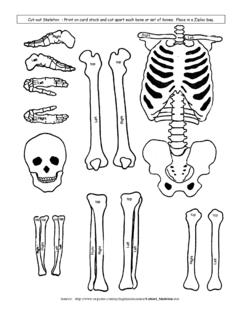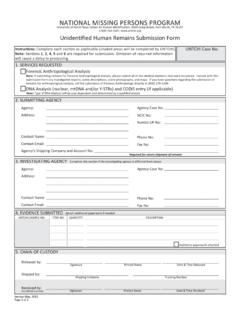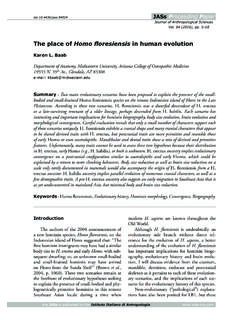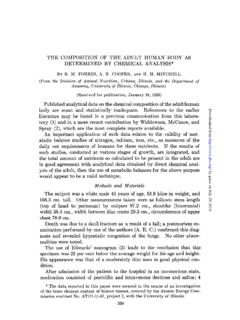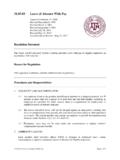Transcription of Course Syllabus BIOD 151 4 credits - Portage Learning
1 Course Syllabus biod 151 essential Lab human Anatomy & Physiology I 4 credits Prerequisites: General biology and chemistry (recommended but not required) Instructor: Renee Correll, DPT Facilitators: Rebekah Stepp, MS, CRNP Crista Bush, MOT, OTR/L Jerrod A. Poe, Tammie Kephart, MS, RDN, LDN Kelly Straley, CRNP Alycia Dalbey, MPAS, PA-C Brandon Zangus, MOT, OTR/L Brittany Martinez, Heidi Burtt, DPT Contact Info: Faculty may be contacted through the Portage messaging system Course web site address: Course meeting times: biod 151 is offered continuously Course Description: essential Lab human Anatomy & Physiology I is a systematic integration of the structure and functioning of the cells, tissues, organs and systems of the human body.
2 The laboratory component of this Course is delivered using virtual labs and interactive simulations. Course Outcomes: As a result of this Course experience a student should be able to: Identify and explain the function of all cell organelles Explain all types of cellular transport including diffusion, facilitated diffusion, active transport, exocytosis, endocytosis, phagocytosis, and pinocytosis Understand basic microscopy Understand and correctly use basic anatomical terminology Understand the anatomy and physiology of the respiratory system Understand the anatomy and physiology of the digestive system Understand the anatomy and physiology of the skeletal and muscular systems Understand the anatomy and physiology of the endocrine system Understand the anatomy and physiology of the integumentary system Lab Outcomes: As a result of this laboratory experience, students should be able to.
3 Practice safe procedures within a laboratory Identify basic components of a light microscope Understand and demonstrate anatomical position Differentiate between types of epithelial tissue and describe their function Differentiate between types of connective tissue and describe their function Identify anatomical structures of the respiratory system Understand pulmonary function testing and basic spirometry Identify anatomical structures of the digestive system and their function Identify all major bones within the axial and appendicular skeleton and understand the function of bone Identify all major muscles/muscle groups within the axial and appendicular divisions and understand their function as well as nervous innervation Each of these biod 151 student Learning outcomes is measured: Directly by: (1) module application problems (with instructor feedback) (2) exams (3) lab reports and lab exams (4) comparison of pre- Course / final exam results Indirectly by an end of Course student-completed evaluation survey Course Delivery: This Course is asynchronously delivered online and is composed of 40 - 50 hours of reviewed module assignments with instructor feedback, 10 contact hours of secure online module exams, 15 20 hours of observation of demonstration labs and maintenance of a lab notebook, and 8 hours of lab exams.
4 It is the policy for all Portage Learning courses that only one exam be completed each day. Research on best practices in Learning psychology indicates that time is needed to process material for optimal Learning . This means that once an exam has been completed, the next exam will not unlock until the following day. Please plan your time accordingly. If you have a legitimate need for an exception to this policy, please contact your instructor. Required Computer Accessories: It is recommended that students use a desktop or laptop computer, PC or Mac, when taking the Course . Some tablet computers are compatible with the Course , but not all features are available for all tablet computers. The latest full version of Firefox is required for the optimal operation of the Portage Learning Management System.
5 In addition, you must have the latest full version of Adobe Flash Player installed as a plug-in in order to view any of the videos on the site. We highly recommend using a high-speed Internet connection to view the video lectures and labs. You may experience significant difficulties viewing the videos using a dial-up connection. Required readings, lectures and assignments: Portage courses do not use paper textbooks. Students are required to read the online lesson modules written by the Course author which contain the standard information covered in a typical Course . Please note the exam questions are based upon the readings. The practice problems within the modules are not quantitatively part of your final grade, but the module work is a pass/fail component of the Course and will be reviewed for completeness by the instructor.
6 These are not an option or a choice; they are required. This means that you must complete all of the review questions within the modules. Be sure to answer all of the problems in your own words at all times, since this is an important part of adequate preparation for the exams. After you answer the practice problems, compare your answers to the solutions at the end of the module. If your answers do not match those at the end, attempt to figure out why there is a difference. If you have any questions please contact the instructor via the My Messages tab. Required labs and assignments: For the laboratory portion of the Course , students will observe an experienced lab instructor. It is the responsibility of the student to view each lab video in its entirety and only mark the lab as done when it is completed.
7 Do not open all the labs at once; otherwise, they may be reset at the discretion of the instructor. Students are encouraged to keep a lab notebook while watching the videos. The lab notebook, alone, can be used as a resource to the student while taking their lab exam(s). Please note that the use of outside material ( the internet, textbooks, articles, etc.) is not permitted while taking the lab exams. A recommended lab schedule can be found on the home page of each lab; the student should follow this schedule to meet Course objectives. Grading Rubric: 7 Module exams = 100 pts. each x 6 = 700 pts. 8 Lab exams = 40 pts. Each x 8 = 320 pts. Final exam = 120 pts. 120 pts. Total 1,140 pts. The current Course grade and progress is continuously displayed on the student desktop.
8 Grading Scale: - 100% (949 - 1060 pts) = A - (843 - 948 pts) = B - (737 - 842 pts) = C - ( 631- 736 pts) = D < (<631 pts) = F Module & Lab Topics Module 1: In this module students will be introduced to the general function of each body system. In addition, basic anatomical terminology is covered including directional terminology and anatomical planes. Content also includes coverage of cell metabolism. This module will also introduce the structure of eukaryotic cells including an in-depth description of the cell membrane as well as cell organelles and their function. Module 2: In this module, students will receive an overview of the anatomy of the respiratory system including histology of the respiratory tract as well as specialized cells.
9 Students will cover detailed physiology of all aspects of respiration including breathing, internal/external respiration, and aerobic cellular respiration. Practical application is provided through the overview of common pathology of the respiratory system. Module 3: In this module, students will receive an overview of the anatomy of the entire GI tract. Content covers the physiology of mechanical and chemical digestion throughout the GI tract as well as the role digestion plays in the body s ability to produce energy. Module 4: In this module, students will be introduced to the skeletal system. Content includes a comprehensive anatomical overview of types of bones and joints. Students will be introduced to all major bones, ligaments, and joints throughout the body.
10 This module also includes a physiological overview of bone development and common pathology of the skeletal system. Module 5: In this module, students will be introduced to the muscular system. Content includes a comprehensive anatomical overview of major muscle groups throughout the body, including origin, action, insertion, and nervous innervation. This module also includes a physiological overview of muscle contraction. Module 6: In this module, students will be introduced to the endocrine system. Content includes an anatomical summary of all endocrine glands and the hormones that they produce. Students will learn the physiological effects of hormones on the organs that they target. Module 7: In this module, students will be introduced to the integumentary system.


